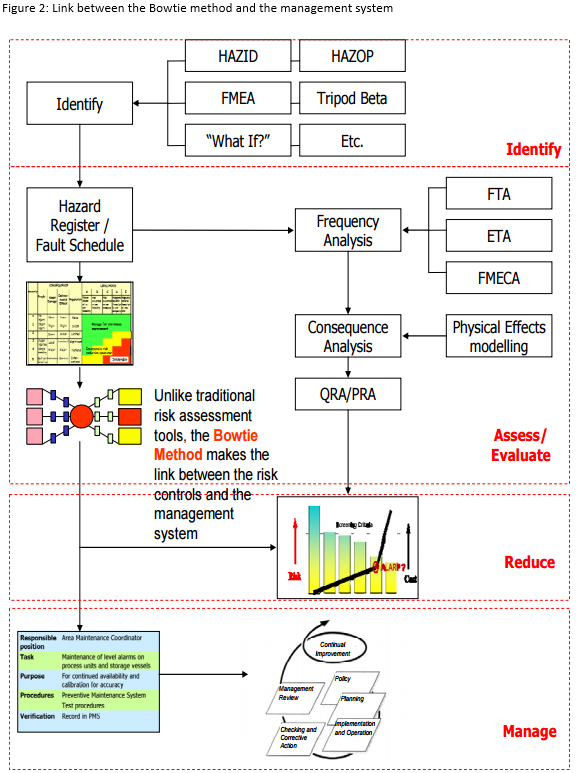Using the bowtie method to evaluate the risks in a construction project
(→Annotated bibliography) |
|||
| Line 62: | Line 62: | ||
- How might controls fail or effectiveness be reduced? | - How might controls fail or effectiveness be reduced? | ||
| − | - How are control failures prevented?''” | + | - How are control failures prevented?''” <ref>Risk Assessment, ''A practical guide to assessing operational risks'' by Georgi Popov, Bruce K. Lyon & Bruce Hollcroft page 184 |
= Description of the Bowtie method = | = Description of the Bowtie method = | ||
| Line 133: | Line 133: | ||
=References= | =References= | ||
http://www.risktec.co.uk/media/43525/bow-tie%20lessons%20learned%20-%20aiche.pdf | http://www.risktec.co.uk/media/43525/bow-tie%20lessons%20learned%20-%20aiche.pdf | ||
| + | |||
| + | Risk Assessment, A practical guide to assessing operational risks by Georgi Popov, Bruce K. Lyon & Bruce Hollcroft page 184 | ||
http://www.caa.co.uk/Safety-initiatives-and-resources/Working-with-industry/Bowtie/Bowtie-elements/Consequences/ | http://www.caa.co.uk/Safety-initiatives-and-resources/Working-with-industry/Bowtie/Bowtie-elements/Consequences/ | ||
Revision as of 08:18, 26 September 2016
Dear reader, this article is not 100% finished yet, the case and discussion part will be elaborated. The figures need an explanation to give a clear overview of what the are. The annoterede bibliography also needs elaboration.
Abstract
The primary goal of risk management in construction is to give a systematic approach to identify and respond to potential risks which may arise during the lifespan of a project.
The risk exposure for construction projects arise from the very beginning of the development idea, to the handover and following operation of the site. During all phases, there are many aspects where risk is involved. A few of these aspects include, project material e.g. architectural drawings, communication platforms, safety of craftsman, weather conditions, force-majeure, finances and stakeholder engagement. Thus, it is important to start a risk management process before actually starting the construction project, in order to create a systemic, and analytically sound way of managing risks throughout its lifespan.
This article will focus on a method to assess potential risks within construction, specifically using the Bowtie method as a reference point. When having read the article the reader will have a deeper insight into the Bowtie method in theory as well as have insight as how to apply the Bowtie method in real case scenarios.
Introduction
In short, the Bowtie method visualizes the hazardous events that are present during a project, it gives an overview of multiple plausible scenarios that can occur during a project. The bowtie method was inspired be three different methods, The fault tree, the event tree and casual factors charting. The combination of these three risk assessment methods give an extensive overview of what the risks are, how to prevent them, what to do it the risk becomes “alive” and what the following consequences are.
The precise origin for when the Bowtie method was developed is not completely clear. One of the first large corporations that used the Bowtie method was the Royal Dutch / Shell Group. They started using this method because of the explosion leading to 167 deaths on the Piper Alpha platform in 1988. The motivation for Shell was to ensure that the necessary risk controls are consistently in place in all operations worldwide.
The Bowtie method is often used in the gas and oil industry, however it has gained a lot of support from other companies and industries because the method keeps an easily read overview of risk management practices.
The Bowtie method a qualitative hazard assessment tool and unlike traditional assessment tools because it has a direct link between the risk controls and the management system.
When analyzing and demonstrating the relationships in risky scenarios the Bowtie method is a good tool to use. By communicating the risks and providing a clear roadmap the bowtie method is a risk evaluation method that gives a visual understanding of plausible accidents that exist concerning a specific hazard. It identifies control measures that can be used by a company to control the outcome of the hazard.
Unlike some evaluation methods the Bowtie method is more detailed by identifying ways these control measures fail. These are known as escalation factors. The escalation factors also have possible control measures. The method also shows the mitigation measures and consequences for the hazard in question.
When using a Bowtie diagram, it should also be considered that management systems are to be integrated. By doing this it is possible to visualize the activities that keep a control working and who is responsible for this. Before using the Bowtie method an initial investigation of failures and unwanted events must be carried out, this can be done by using FMEA (Failure mode and effects analysis).
The key activities in the Bowtie model is:
1: Identify major hazards and top event
2: Identify the threats
3: Identify the consequences
4: Identify the prevention and recovery controls
5: Identify escalation factors and controls
“Some important questions to consider when developing a Bowtie diagram include the below questions:
- What are the hazards and their causes?
- What occurs when control is lost?
- What are the potential consequences?
- How can the hazard be avoided?
- How can the organization recover should the event occur?
- How can the likelihood and/or severity be limited?
- How might controls fail or effectiveness be reduced?
- How are control failures prevented?” [1]
Cite error:
<ref> tags exist, but no <references/> tag was found
